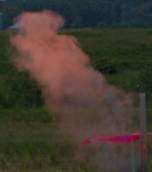| | NARAM-46 | |
| |
| |
| |
| | | | |
| |
| The payload needs to be completely enclosed in the model, and remain inside the model from launch to return. Nothing can be permanently attached (i.e. glued) to the payload. Payload Altitude models can be staged, though this does not seem to be beneficial for B class based on the current choice of engines. Payload models MUST use a PARACHUTE for recovery. The chute needs only to be large enough for a safe recovery. For the full rules for this event, please see the Payload Altitude Rules on the NAR web page. Scoring - For Payload Altitude, the scoring is best SINGLE qualified flight altitude of two flight allowed. The model must be returned on each flight, in order to confirm the payload was not altered or lost any mass. Design considerations - Designing and building a low-drag model that must hold a one ounce payload that is the same diameter as most body tubes used for 18mm engines, to fly as high as possible Payload specifications - To quote the Pink Book rules, from 25.2:
No need to grab any calipers, here's what this effectively means: The payload diameter happens to be about the same external diameter as an Estes BT-20 body tube. Payload models need to have a payload section that is larger in diameter than the payload in order to house the BT-20 diameter payload inside. The payload length can vary from 60mm (2.362") to 80mm (3.15"). NARAM-46 payloads - NARAM payloads will be provided for all contestants, so you do not have to bring your own. If you do provide your own, a few days before the event if flown the contest officials will measure, weigh and mark your payload. Contestant provided payloads will be impounded until they check-in to fly the event. NARAM-46 payloads will be made out of Estes BT-20 tubing, so make sure your payload models can hold a BT-20 payload inside. As this is being written, the length of the NARAM payloads is not yet known. That is because prototype NARAM payloads have not been made yet. Once the length of the NARAM-provided payloads is known, the length will be announced here. For those who want to design and fly now, build your models to hold the maximum length possible (3.15"). Later you can shorten the payload section based on the NARAM payload length. Building and flying this event - There are not many good plans available for this event. Before July 1979, the NAR standard payload was a very short (1/2" long by 19.1mm diameter) lead cylinder. This is why earlier payload designs had short payload sections as they were designed to loft 1/2" lead payloads. Payload is not flown as often today, so there are not many published designs for the longer (sand-containing) payloads. The list of plans is somewhat limited and some of the old lead payload plans would need for the payload sections to be lengthened quite a bit. Fortunately, ASP and QCR have contest-quality payload rocket kits available, as listed further down this page. If the old Apogee B7 motors (13mm diameter) were still contest certified, the optimal designs for this event would look much different with the rear half of the models tapering down to 13mm tubing. As staging 13mm A's is not a good choice this narrows the practical options to a single 18mm B engine. A key to any altitude event is building the model to fly straight and true. Work towards attaching all of the fins so they are straight and parallel to the body. This should translate to a straight boost, with minimal wobbling that would hurt the altitude. A good finish is important for altitude models. Don't overdo it though, it helps to keep the model as light as possible, even though it is carrying a one ounce payload. As weight goes up, peak altitude goes down. Try to focus on light weight designs and not build too heavy. Sources for 20mm tubes and noses - If you want to build from a plan, or design from scratch (instead of using the ASP or QCR kits), here are sources for the body tubes that slip fit over BT-20 tubes and nose cones to go with them:
|
| Model Plans & Kits | Designer | Notes |
| ASP - "Versi - Loader 18" payload rocket kit | ASP (Aerospace Specialty Products), Andy Jackson | Good competitive kit for 18mm engines. |
| QCR - No-Part II kit - Payload A, B, or C | QCR - Qualified Competition Rockets, Ken Brown | Good competitive kit for 18mm engines |
| AWN-22 C Payloader plan (from NAR website) | Plan by Dave Cook | This record-setting FAI model from 1980 used the old phased-out 1/2" tall lead payload. This design needs its payload section be modified to contain the long paper tube and sand type payloads. |
| Quest "Sprint" Sport rocket kit | Quest Tip from Kevin Wickart >> | A sport kit that can be converted for Payload. Cut off about 4" of the forward part of the body tube as a payload section, and add a nose block bulkhead. |
| ASP - NAR sand payload kit, #PAY - 28 | ASP (Aerospace Specialty Products), Andy Jackson | NOT a rocket, this is a sand PAYLOAD in kit form. |
return to top
